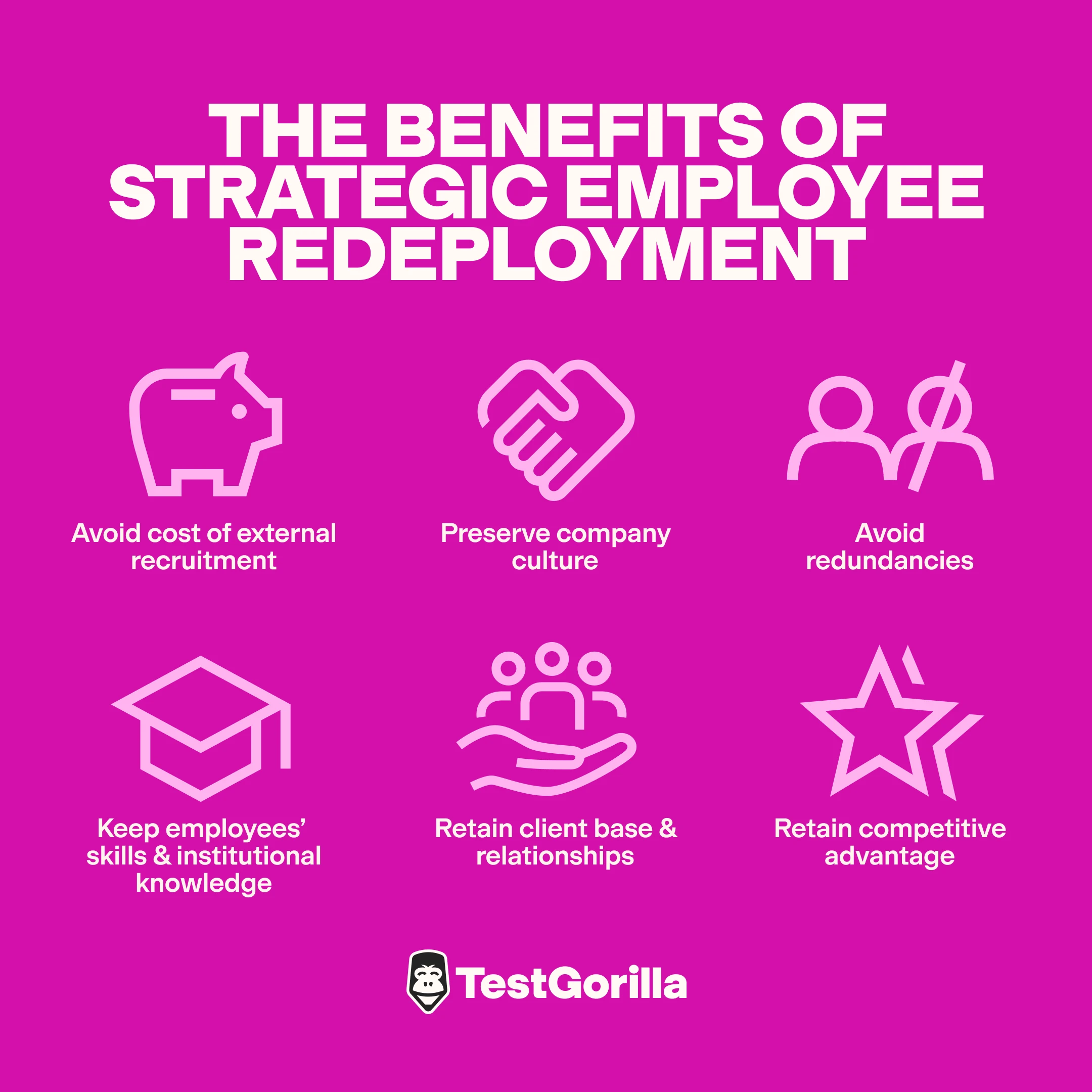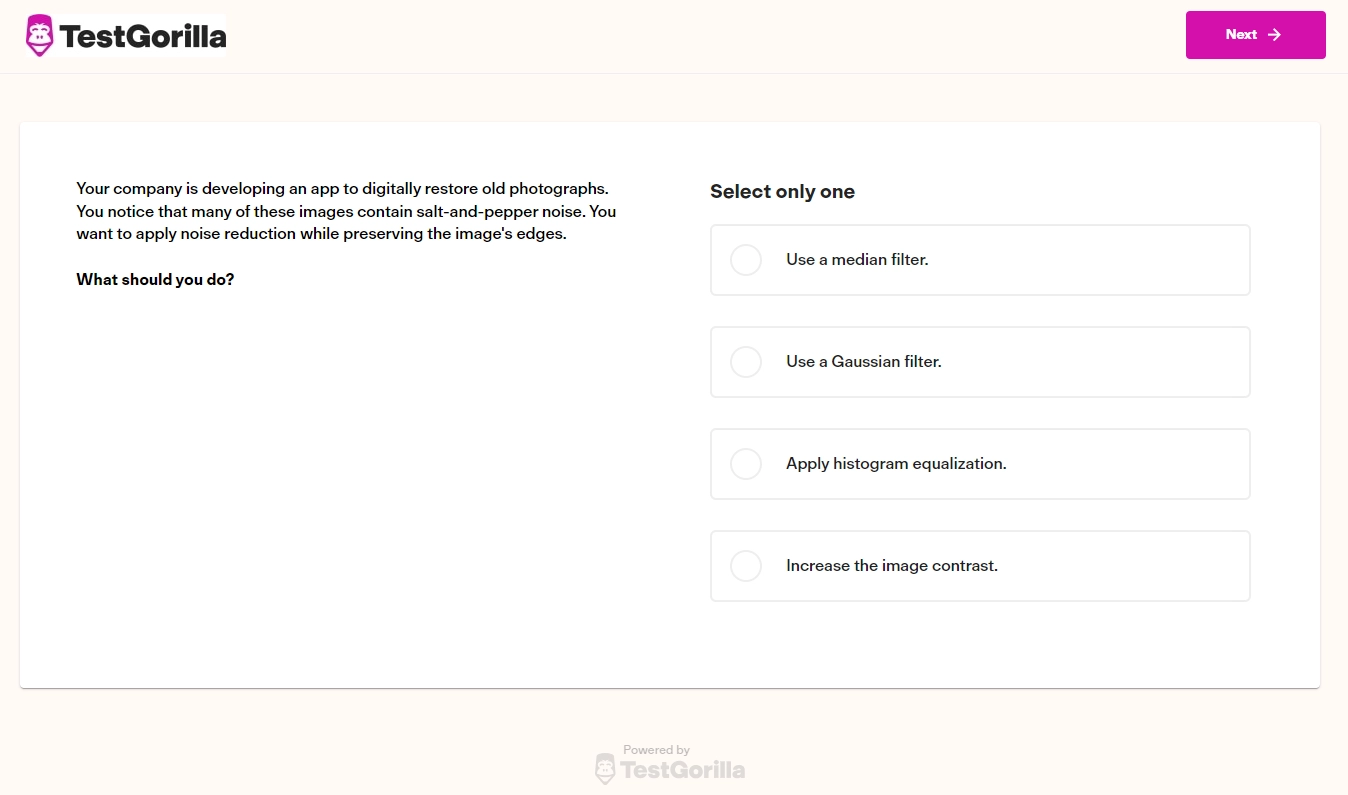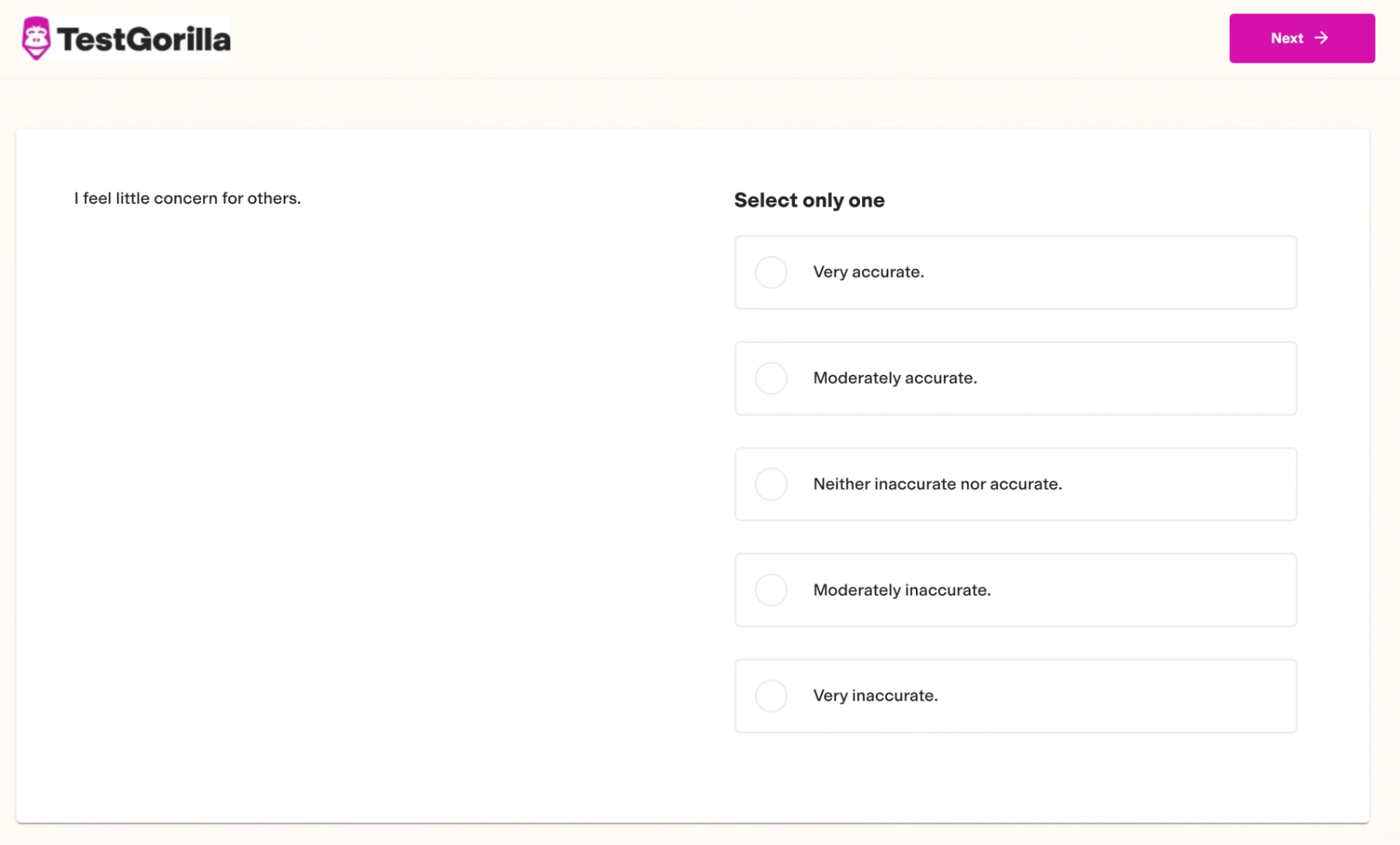A skills-based approach to workforce redeployment
Take a skills-based approach to workforce redeployment
Workplace redeployment is a powerful way for companies to reduce costs, re-strategize, and remain agile in a complex environment. Used correctly, it minimizes the need for layoffs and prevents companies from rebuilding their talent pool from scratch.
However, implementing redeployment strategies isn’t always simple. To leverage your resources effectively, you need to take a skills-based approach to redistribute the workforce and discover which employees have transferable skills like critical thinking. Below, we explore the concept of workplace redeployment and share steps to implement an effective strategy.
What is workforce redeployment?
Workplace redeployment is the process of moving an employee from one role to another. Usually, it’s a strategy implemented to reduce redundancies. The new role doesn’t have to be similar to the previous one – it can pay differently, have different responsibilities, and even be in a different location.
Here are some examples of redeployment in action:
Workforce redeployment type | Example |
Large-scale | Your commercial data team is overstaffed, so you decide to redeploy some of your commercial data analysts to similar roles in your product data team. |
Individual | You notice that one of the junior employees in your customer service team is particularly good at writing responses to customers, so you redeploy them as a copywriter, a role with a clearer path of progression. |
Used correctly, a redeployment strategy preserves company culture, ensures you retain key skills and experience, and helps you avoid the costs of external recruitment.
Additionally, employee redeployment helps ensure you comply with industry and national regulations. For example, in the United Kingdom, companies must offer “suitable alternative employment” to employees at risk of redundancy if it is available.
What is skills-based workforce redeployment?
Skills-based workplace redeployment involves using talent assessments and examining the skills that overlap between roles when determining where to place employees. It’s an alternative to focusing on “experience overlap” or other factors.
We go into more detail on skills-based redeployment below, but our own Maria Villegas is a great example of the skills-based approach.
Before working at TestGorilla as an SEO specialist, Maria had studied medicine for six years. We might have missed out on Maria’s skills if we’d taken a traditional approach that focused on resumes. But using a skills-based approach revealed she had everything she needed to thrive in the role – and she has!
Takes a skills-based approach to redeployment with TestGorilla
Skills tests help determine where employees fit in your organization based on their abilities, personality, and characteristics.
8 steps to a skills-based workforce redeployment strategy
Now that you have a clear redeployment definition and understand the benefits of employee redeployment, you can begin building a skills-based approach to redeployment.
A skills-based strategy for redeployment at work requires careful assessment of your employees' skills and business needs throughout the process.
Here are our eight tips for implementing a skills-based workforce redeployment strategy.
1. Create an official redeployment policy
Managing workplace redeployment effectively starts with documenting a clear policy for how you approach redeployment strategies.
Even before laying off employees or restructuring your teams, a clear policy helps you make decisions based on the situation at hand, circumstances you encounter in the future, and your desired work environment.
Create a redeployment policy document accessible to all employees (and even potential candidates) covering all possible aspects of redeployment, including:
Which employees are eligible for redeployment opportunities, e.g. employees at risk of redundancy who have worked with your company for at least six months
What providing “suitable alternative employment” means for your organization
How the application and shortlisting process works for redeployees
What trial period you offer, and when it’s up for review
2. Build strong internal networks
Another key aspect of a strong workplace redeployment strategy is internal networking.
Networking creates a cohesive culture in your organization, so redeployees don’t feel unwelcome entering new teams.
Your repositioned staff feel more comfortable if they’re working with people they’ve already encountered during previous cross-functional collaboration projects.
Consider:
Conducting remote team-building activities like virtual scavenger hunts
Implementing mentoring and reverse-mentoring initiatives
Creating a culture committee with representatives from every team
Implementing regular cross-functional training initiatives
That last point is a big one because cross-functional teams also drive innovation. According to research by Deloitte, 83% of digitally maturing companies use cross-functional teams compared with just 55% of early-stage organizations.
3. Invest time in employees’ career planning and progression
The need for growth is the top level of what Gallup calls employees’ “engagement needs.” Every employee wants to see a future with your organization.
Providing growth opportunities is key to making your redeployment strategy successful.
Investing in your employees’ career growth with upskilling and reskilling initiatives and succession plans boosts staff engagement and performance. It also makes it easier to spot effective skills-based redeployment opportunities because you can clearly see which team members are developing skills that prepare them for new roles.
Invest in advertising growth opportunities within your business by:
Incorporating career planning workshops in learning and development plans
Making career planning a key part of quarterly and annual feedback sessions
Connecting new recruits with mentors who hold senior positions in the business for personalized career planning
4. Evaluate your existing team for skill gaps
Before you begin redeploying employees into your workplace, you need to identify the roles that need to be filled within your organization.
Start by analyzing the skill gaps in your workforce.
To determine where gaps lie, you need to conduct skills assessments of your existing employees.
Identify which skills are crucial to achieving your business goals, then assess which teams lack these skills.
For instance, if you’re a tech company investing in the cutting-edge artificial intelligence landscape, you might be determining where to redeploy an employee with computer vision skills in your team.
Using TestGorilla’s Computer Vision test, you can determine if your product development team currently lacks these skills. This helps you identify where your redeployment candidate can have the biggest impact.
When you use skills tests to identify gaps before an employee redeployment process, you avoid redundancies.
You make the most of your existing resources by placing staff members in the roles that drive the best results.
Discover and fill skill gaps with TestGorilla
Skill tests that focus on essential skills for your organization help you identify gaps in your workforce. Get started today with five free tests!
5. Use skill tests to improve internal and external recruitment
Consistent skill testing is an excellent way for companies to more effectively build, organize, and utilize their human resources. When you’re a hiring manager finding new team members, skill testing ensures you choose candidates with the competencies to thrive in a role.
For example, 7Systems used TestGorilla skills tests to identify the employees who would introduce critical skills and drive the most value for their organization.
When you’re implementing redeployment strategies, skills tests ensure you effectively transfer team members between roles.
You can use an analysis of employees’ existing skills and skill gaps within your teams to optimize horizontal or lateral movements of employees between departments and roles. Plus, skills analysis shows you where you need to upskill and train team members to prepare them for various internal recruitment strategies.
You can even use testing to identify how new and existing employees add to the culture of your various teams by introducing valuable personality traits.
For instance, if a current team is struggling from a lack of leadership, a personality test like the DISC Personality test identifies characteristics in a current team member that help them lead, motivate, and influence colleagues.
6. Manage your communication carefully
Carefully managing communication is crucial to ensuring that employees are never left in the dark about job security, particularly when layoffs are occurring.
A Harvard study found many employees reported stress and anxiety due to communication issues, such as when managers:
Announced that layoffs were coming but not who was at most risk
Laid people off one at a time over long periods
Let rumors run amok without confirming or denying anything
If you have an employee redeployment policy in place, this handles some of the communication. Share your policy with your team even before redeployment strategies commence so teams know what to expect.
Outline the key stages of redeployment carefully. Tell your employees when they need to make a decision, what upskilling opportunities are available, and how long the
onboarding process takes.
7. Give redeployed employees clear performance expectations
Redeployment in business can cause disruption and concern among teams. If you want retention of your employees’ loyalty, show them respect by sharing clear expectations.
Give each redeployee a clear job description, complete with:
A list of responsibilities, including any management responsibilities
The key performance indicators for the role
How are these benchmarks decided, and by who
When these benchmarks are up for review
Clearly outlined roles and responsibilities help redeployed employees decide if a new position suits them. For instance, someone used to a role that involves a lot of face-to-face contact with clients, like direct sales, might not find a new job that focuses more on hitting engagement targets, like social media management, as fulfilling. Letting them know what to expect in advance means they have time to request an alternative repositioning strategy or ask for training to help prepare them for a new role.
8. Provide training, support, and coaching during the transition and onboarding period
Finally, don’t be tempted to rush employees through redeployment at work.
To get high-quality work and reap the rewards of your efforts by following the tips above, you need to make time for onboarding, learning, and development.
Effective onboarding isn’t just a crucial hiring trend that helps introduce new hires to your company culture. It also prepares redeployees for new responsibilities and fortifies their understanding of your company’s vision and values.
Similarly, a comprehensive training and development program ensures that redeployed employees effectively transition into their new roles. Mentorship programs, coaching sessions, and training days facilitate a rapid transition.
They also show employees concerned about workforce redeployment that you care about helping them thrive within your organization.
Use your skill gap analysis and talent assessments to create personalized onboarding, coaching, and development journeys for each redeployed team member. This not only improves your chances of workplace redeployment success but also boosts staff loyalty.
The best insights on HR and recruitment, delivered to your inbox.
Biweekly updates. No spam. Unsubscribe any time.
Mastering workplace redeployment with a skills-focused approach
Redeployment in the workplace is emerging as a common strategy among organizations looking for a way to reduce redundancies with upskilling strategies and internal movement. While employee redeployment can be difficult to master, taking a skills-based approach helps you maximize the value of your resources. TestGorilla’s test library helps you discover skill gaps, identify the best redeployment opportunities, and create a culture of constant optimization.
Sign up for our Free forever plan for unlimited access to valuable tests to guide your redeployment strategy.
Alternatively, take our product tour to see the full range of tests available, or request a demo to see our assessments in action.
Redeployment FAQs
Do you still have lingering questions about redeployment? Find the answers here:
What is the definition of redeployment in the workplace?
Redeployment in the workplace involves moving a staff member from one role into another. It is a strategy that helps companies minimize the risk of redundancies and preserve crucial talent within the workplace.
What are some examples of workplace redeployment?
Examples of workplace redeployment include a leader moving an American employee who speaks Spanish from an over-staffed US-based sales team into an understaffed Mexico-based marketing team needing additional bilingual assistance. Alternatively, a customer service specialist may be moved to a product development team based on their skills.
Is workplace redeployment good for workers?
Redeployment reduces redundancies, ensuring team members maintain a role in the business and reducing the need to hire new employees. This means it can be a positive thing for both parties, provided the employee is happy with the new role offered.
Related posts
You've scrolled this far
Why not try TestGorilla for free, and see what happens when you put skills first.






















